Rotation Mount with Resonant Piezoelectric Motors

- SM1-Threaded Rotation Mount with Closed-Loop Positioning
- Open Frame Design for OEM Applications
- Control via Interface Board, GUI, or ASCII Message Calls
- Fully Integrated Drive Electronics
ELL14K
Rotation Mount
Bundle
(Mount and Board Included)
Rotation Mount for Ø1" or Ø25.0 mm Optics
(Also Available Individually)
Interface Board
Application Idea
The ELL14K rotates a mounted, SM1-threaded polarizer within a 60 mm cage assembly.
ELLB
Bus Distributor

Please Wait
| Key Specificationsa | ||
|---|---|---|
| Travel (No Limit Switches)b |
360° Continuous | |
| Homing Repeatability | 1.75 mrad (0.1°) | |
| Bidirectional Repeatability | 873 µrad (0.05°) | |
| Velocity (Maximum) | 430 °/s | |
| Maximum Total Load | 50 g (1.76 oz)c | |
| DC Voltage Input | 4.5 to 5.5 V | |
| Weight of Mount | 80 g (2.82 oz) | |
| Minimum Lifetimeb | 100 km (>600 000 Revolutions) | |
| Mount Dimensions |
66.0 mm x 82.5 mm x 19.0 mm (2.6" x 3.25" x 0.75") |
|
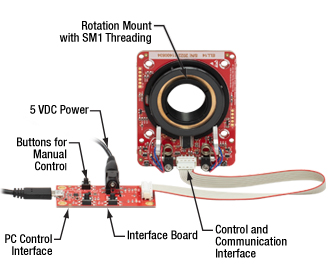
Click to Enlarge
The components of the ELL14K Rotation Mount Bundle are shown connected and with key features labeled.
 Thorlabs' Elliptec Technology for OEM
Thorlabs' Elliptec Technology for OEM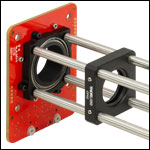
Click for Details
The rotation mount can be adapted for post mounting using SR025 cage rods and a post-mountable 30 mm cage plate.
Features
- Ideal for OEMs and Applications Requiring Rapid and Precise Optic Rotation
- Micro-B USB and Picoflex®1 Connectors for Control Signals
- Multi-Drop Serial Communication Protocol Supported
- SM1-Threaded Rotation Mount for Ø1" or Ø25.0 mm Optics
- Absolute Home Position Found with Infrared and Magnetic Sensor Technologies
- Magnetic Encoder Used to Position Mount
- Bus Distributor Facilitates Control of up to Four Elliptec® Devices
- ELLC2 Accessory Upgrade Pack Available Below
Driven by Thorlabs' Elliptec® piezoelectric resonant motor technology, this rotation mount is designed to be a compact solution for applications requiring optic rotation. The rotation mount is offered as a standalone unit (Item #'s ELL14 and ELL14/M), or as part of a bundle (Item #'s ELL14K and ELL14K/M), which also contains an interface board for manual control of the mount, mounting brackets, power supply, and cables for connecting the mount and interface board to each other and to a PC. Thorlabs also offers the ELLC2 Accessory Pack which can be used to upgrade standalone units to kits.
The rotating cell of each mount is internally SM1 (1.035"-40) threaded and includes two SM1RR retaining rings for mounting Ø1" or Ø25.0 mm optics. It is designed to be lightweight and compact, and the closed-loop operation provides rotation to specified orientations with a repeatability of 873 µrad. The assembled components of the ELL14K are shown in the image to the far right, with key features labeled. Please see The Elliptec® Motor tab for more information.
The motors are highly dynamic and have no gearing. The tips of both motor housings are in firm contact with the plastic track at the base of mount, as can be seen in the image at the right. The motors are installed with opposite orientations and translation in both directions occurs when one motor pushes the track forward while the other pulls it backward. The rotation mount is not designed for continuous operation. We recommend operation with duty cycles of 40% or less. When power is not applied to the motors, the stage is held in place by an approximately 0.01 N·m combined torque exerted by the stationary arms of the motors.
The open frame format, versatility, and simplicity of this rotation mount makes it attractive for OEM applications, as it can be customized according to customer requirements and produced in high-volume quantities. Please contact us to discuss your specific requirements so that we may tailor a solution to meet the needs of your application.
Control
There are multiple options for powering, driving, and controlling this rotation mount, which are detailed in the Positioning the Rotation Mount section of the Operation tab. The mount possesses a 3.3 V serial bus and is designed to be operated with or without the interface board; the Pin Diagram tab provides pin assignments. Thorlabs offers software for our Elliptec products capable of providing full and independent control of the mount. When the interface board is used as an accessory to change the position of the mount, its status in the software is automatically updated.
| Elliptec Resonant Motor Products | |||||
|---|---|---|---|---|---|
 |
 |
 |
 |
 |
 |
| Multi-Position Sliders | 28 mm Linear Stage | 60 mm Linear Stage | Rotation Stage | Rotation Mount | Motorized Iris |
Multiple Elliptec devices can be controlled using the ELLB Bus Distributor or by splicing multiple connectors onto one ribbon cable. A single bus distributor can connect up to four Elliptec devices; up to 16 devices can be connected if the buses are daisy chained. This bus can be controlled one of three ways: through an interface board (included with the bundles below) to connect to a PC running the Elliptec software, by connecting to an Arduino®2 or Raspberry Pi®3 board, or by wiring the connector pins to a user-supplied control board. Alternatively, up to 16 devices can be spliced onto a single ribbon cord. The devices can then be simultaneously controlled by the interface board or selectively controlled by the Elliptec software. See the manual for instruction on how to splice multiple devices onto a ribbon cord and the Pin Diagrams tab for pin assignments when making custom connections.
- Picoflex is a registered trademark of Molex Incorporated.
- Arduino is a registered trademark of Arduino Sa Société Anonym (SA).
- Raspberry Pi is a registered trademark of the Raspberry Pi Foundation.
| Specificationsa | |
|---|---|
| Performance | |
| Travel | 360° Continuousb |
| Maximum Speedc | 430 °/s |
| Bidirectional Repeatabilityd | 873 µrad (0.05°) |
| Homing Repeatability | 1.75 mrad (0.1°) |
| Bidirectional Accuracye | 6.98 mrad (0.4°) |
| Backlash | 226.9 µrad (0.013°) |
| Encoder Resolution (Relative Magnetic Encoder) | 143360 counts/rev (43.8 µrad/count) (0.0025°/count) |
| Minimum Incremental Motion | 34.9 µrad (0.002°) |
| Minimum Holding Torque (Both Motors Engaged) | 0.01 N•m |
| Axis Wobblef | 244.3 µrad (0.014°) |
| Maximum Total Loadg | 50 g (0.11 lb) |
| Minimum Lifetimeh | >600 000 Revolutions (100 km) |
| Electrical | |
| Motor Type | Elliptec® Resonant Piezo |
| DC Voltage Input | 4.5 to 5.5 V |
| Typical Current Consumption, During Movement | 800 mA |
| Typical Current Consumption, During Standby | 50 mA |
| Communications | |
| Bus | Multi-Drop 3.3 V/5 V TTL RS232 |
| Connector on Rotation Stage Board | Picoflex® |
| Connectors on Interface Board | Picoflex®, Micro USB, DC Jack [6.3mm OD (GND), 2.1mm ID (+5V)] |
| Speed | 9600 baud |
| Data Length (1 Stop Bit, No Parity) | 8 bit |
| Protocol Data Format | ASCII HEX |
| Module Address and Command Format | Mnemonic Character |
| Mechanical | |
| Mounting Thread | SM1 |
| Dimensions of the Rotation Mount Board | 66.0 mm x 82.5 mm x 19.1mm (2.6" x 3.25" x 0.75") |
| Weight of Rotation Mount Board | 80 g (0.176 lb) |
| Environmental Operating Conditions | |
| Temperature Range | 15 to 40 °C (59 to 104 °F) |
| Maximum Relative Humidity (Non-Condensing) | <80% at 31 °C |
| Maximum Altitude | 2000 m |
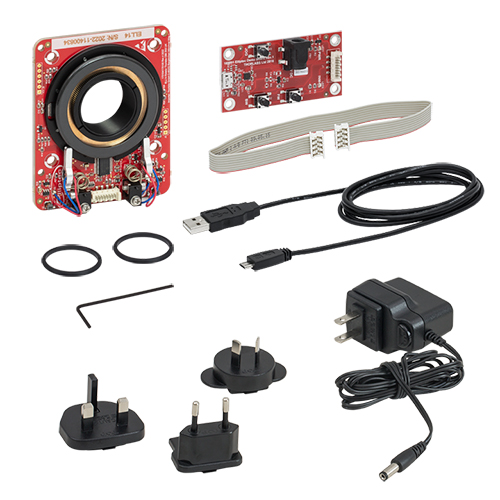
Click to Enlarge
Components of the ELL14K Bundle
(One Region-Specific Power Adapter Included with the Power Supply)
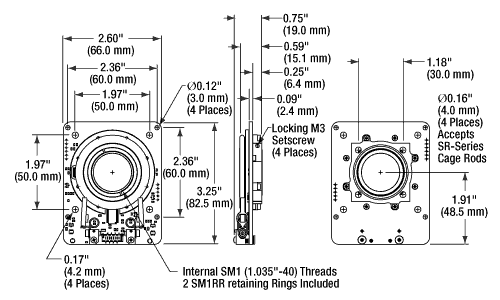
Click to Enlarge
Mechanical Drawing of the Rotation Mount
For more information on mounting options see the Operation tab.
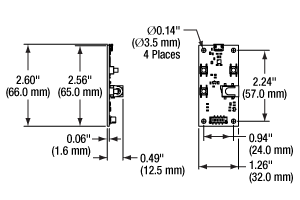
Click to Enlarge
Mechanical Drawing of the Interface Board
| Connector J1 Pinouta | ||
|---|---|---|
| Pin | Type | Function |
| 1 | PWR | Ground |
| 2 | OUT | OTDX - Open Drain Transmit 3.3 V TTL RS232 |
| 3 | IN | RX Receive - 3.3 V TTL RS232 |
| 4 | OUT | In Motion, Open Drain Active Low Max 5 mA |
| 5 | IN | JOG/Mode, Active Low Max 5 V |
| 6 | IN | BW Backward, Active Low Max 5 V |
| 7 | IN | FW Forward, Active Low Max 5 V |
| 8 | PWR | VCC +5 V ±10%; 800 mA |
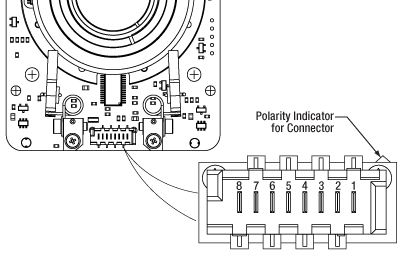
Click to Enlarge
Pinout diagram of the Picoflex® connector is shown referended to a partial diagram
of the ELL14 Rotation Mount Board.
| ELLB Connector J1, J2, J3, and J4 Pinouta,b | ||
|---|---|---|
| Pin | Type | Function |
| 1 | PWR | Ground |
| 2 | OUT | OTDX - Open Drain Transmit 3.3 V TTL RS232 |
| 3 | IN | RX Receive 3.3 V TTL RS232 |
| 4 | OUT | In Motion, Open Drain Active Low Max 5 mA |
| 5 | IN | Not Connected |
| 6 | IN | Not Connected |
| 7 | IN | Not Connected |
| 8 | PWR | VCC +5 V ± 10%; 800 mA per Connected Device |
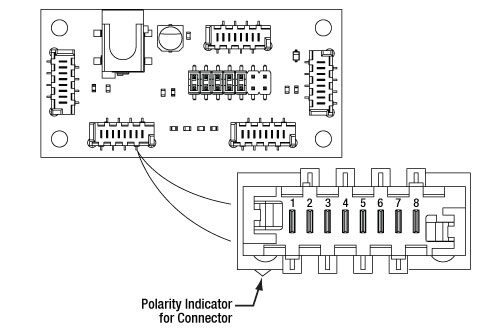
Click to Enlarge
Pinout diagram of the Picoflex® connector is shown referenced to a simplified diagram
of the ELLB Bus Distributor. The polarity indicator on the connector
must be adjacent to the red wire on the supplied 8-connector cables.
Operation Notes
This tab contains information on handling, mounting, and operating the ELL14K Rotation Mount Bundle.
Contents- Handling
- Mounting and Loading the Rotation Mount
- Supplying Power
- Operation of the Motors
- Homing the Rotation Mount
- Positioning the Rotation Mount
- Resonance Frequencies
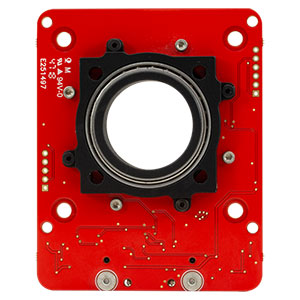
Click to Enlarge
The Rotation Mount, Back
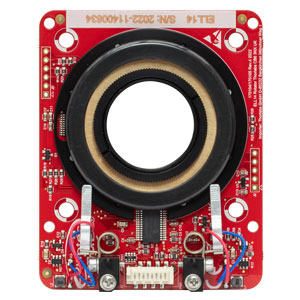
Click to Enlarge
The Rotation Mount, Front
Handling
The rotation mount and interface board included in the ELL14K bundle are robust to general handling. To ensure reliable operation, keep the surface of the plastic track contacted by the motors free of oils, dirt, and dust. It is not necessary to wear gloves while handling the rotation mount, but avoid touching the track to keep it free of oils from fingerprints. If it is necessary to clean the track, it may be wiped with isopropyl alcohol or mineral spirits (white spirit). Do not use acetone, as this solvent will damage the plastic track.
The open frame format of the ELL14 can tolerate up to 8 kV of static discharge. ESD precautions should be taken, as an electrostatic discharge can produce an electrical signal that may cause an unintended movement of the mount. A bending load in excess of 500 g applied to the board may cause the PCB to deform, which will degrade the performance of the rotation mount. As readings from a magnetic sensor are used during the homing and positioning of the mount, avoid subjecting the structural PCB to excessive loads or magnetic fields. Limit the strength of magnetic fields in proximity to the magnetic sensor to ±5 mT to avoid negatively affecting the homing and positioning operations.
Mounting and Loading the Rotation Mount
The rotation mount may be mounted either vertically or horizontally. The Elliptec motors should be facing up if the mount is used horizontally. The mount has several mounting features that can be used with Thorlabs components or within a custom OEM assembly. Four Ø0.12" (3.0 mm) through holes are spaced 60 mm apart and provide compatibility with our 60 mm cage system. These holes can pass 4-40 or M3 screws for mounting to custom structures. Additionally, there are four Ø4.2 mm (Ø0.17") through holes spaced 50 mm apart which can be used with 6-32 or M5 screws for custom mounting. The back of the mount features four Ø4.0 mm (0.16") holes 30 mm apart with locking M3 setscrews for use with our SR-Series cage rods. A 1.5 mm hex key comes with the mount for locking these screws. SR-Series cage rods can be used to attach the ELLA1 adapter to allow for post mounting or to attach ER-Series cage rods for integration into a 30 mm cage system.
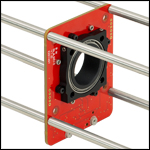
Click for Details
The rotation mount can be mounted in a 60 mm cage system by sandwiching the PCB between two cage rods using the Ø0.12" (3.0 mm) holes in the corners.

Click for Details
The rotation mount can be adapted to a 30 mm cage system using SR025 cage rods in the Ø0.16" (4.0 mm) holes on the back of the mount.
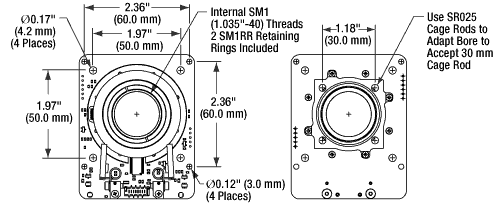
Click to Enlarge
Features of the Rotation Mount
The maximum allowed weight of the mounted optic is 50 g. The load must be centered on the mount in order to acheive 50 g. In all cases of mounting and loading, ensure that nothing interferes with the moving parts of the rotation mount and that the mount and its load are securely fastened to prevent jostling during movement. Jostling of the stage or the load can cause an encoder error.
Supplying Power
When the setup includes the interface board, power may be supplied through the Micro-B USB connector and/or the 5 VDC power socket located on the board. The electronics on the interface board convert the applied DC signal to a sinusoidal signal oscillating at the required resonance frequency.
The ELL14K bundle includes a 5 VDC power supply whose connector mates with the power socket on the interface board. Delivering power through this socket also allows the Micro-B USB connector to be used for a computer to control the mount remotely. The power supplied by a computer through the USB 2.0 connection is not sufficient to power the mount. If computer control is not necessary, another option for supplying power to the mount is a portable USB 5 V battery pack connected to the Micro-B USB connector on the interface board.
When the implementation does not include the interface board, the connection with the power source is made using the pins on the Picoflex® connector that is included on the rotation mount board. A pinout diagram of this connector is included in the Pin Diagram tab, and information on powering and addressing the rotation mount is given in the manual and the communications protocol manual, respectively.
Operation of the Motors
The motion of the rotation mount is controlled by forcing the piezoelectric elements to vibrate at specific ultrasonic frequencies. For each motor, there is one ultrasonic resonant frequency that will push the mount forward, and another that will pull the mount backward. Operating a motor at one of its resonance frequencies causes the tip of the motor to continuously cycle in a tight clockwise elliptical path. When the motor is driven at its other resonant frequency, the tip of the motor cycles through that same path in a counterclockwise direction. Both resonant frequencies are around 100 kHz. The total displacement at the tip of motor is a function of the mechanical load it is driving and the voltage supplied to the piezo element. In the case of no loading and a 5 V maximum driving voltage at a resonant frequency, the tip of the motor expands and contracts no more than a few microns while tracing the elliptical path. Please see The Elliptec® Motor tab for more information and an animation illustrating the operational principle of the motors.
Homing the Rotation Mount
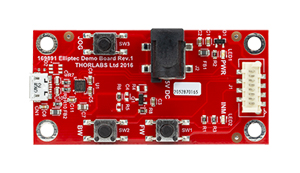
Click to Enlarge
The Interface Board
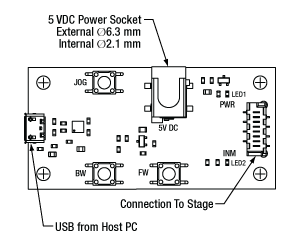
Click to Enlarge
Features of the Interface Board
To Home the mount, press the BW button on the interface board, click the Home button in the Elliptec software's graphical user interface (GUI) or send the appropriate ASCII message as is specified in the communications protocol manual.
The default Home position is referenced to a fixed feature on the mount assembly. If desired, the user may redefine the position of Home to be offset from the default position by up to +90° (a quarter turn in the clockwise direction). Being able to customize the Home position can be useful when synchronizing the orientations of two or more mounts. When executing the Home command, the mount first finds the approximate location of Home, and then a fine-positioning procedure is used to orient the mount at Home with an accuracy of 288.0 µrad. The user can specify whether the mount rotates in a clockwise or counterclockwise direction (as defined from the perspective of looking down on the surface of the mount) during the first phase of the homing procedure, but the fine-positioning phase is always performed in the counterclockwise direction for repeatability.
Positioning the Rotation Mount
Note that the rotation mount is not intended for continuous operation. We recommend operation with duty cycles of less than 40% during general use, while operation with duty cycles greater than 60% should be limited to a few seconds.
Before the mount may be positioned, the Home position of the mount must be found. Please see the previous section for details. The movement of the mount may be controlled through computer control via the Elliptec® software package that may be downloaded, or by sending simple signals to digital lines on the mount's board. A link to download the software and accompanying documentation can be found in the Software tab.
Multiple Elliptec devices can be be controlled using the ELLB Bus Distributor or by splicing multiple connectors onto one ribbon cable. A single bus distributor can connect up to four Elliptec devices; up to 16 devices can be connected if the buses are daisy chained. This bus can be controlled one of three ways: through an interface board (included with the bundles below) to connect to a PC running the Elliptec software, by connecting to an Arduino® or Raspberry Pi® board, or by wiring the connector pins to a user-supplied control board. Note that if an interface board is used, its on-unit buttons will be disabled. Alternatively, up to 16 devices can be spliced onto a single ribbon cord. The devices can then be simultaneously controlled by the interface board or selectively controlled by the Elliptec software. See the manual for instruction on how to splice multiple devices onto a ribbon cord and the Pin Diagrams tab for pin assignments when making custom connections. The communications protocol manual describes how to use the software to individually address each connected device. A link to download the software and accompanying documentation can be found in the Software tab.
The default increment to move the mount forward and backward is 45°, and a custom increment can be set using the Elliptec software or by sending the appropriate ASCII message(s) as specified in the communications protocol manual. The Elliptec software can be used to move the mount to absolute and relative positions, in addition to jogging the mount forward or backward. The software is also used to set the jog step size, read the position of the mount, and adjust the position of Home, as is described in the previous section.
Readings from the magnetic sensor, which can resolve angular increments of 23.8 µrad, are used to position the mount and when executing the Home command. The travel range of the mount is not limited, but the reported orientation of the mount is always expressed as a value between 0° and 359.99°. The minimum incremental movement of the mount is 34.9 µrad, and it can be positioned with a repeatability of 873 µrad in response to signals from the magnetic sensor.
The mount learns to efficiently position itself precisely using a position error compensation algorithm. After the mount moves into a new position, it detects the error between the requested and actual positions. The position of the mount is then corrected, and an error compensation value is calculated. The algorithm is then updated with the error compensation value, so that it is applied when the mount is move to its next position. Typically, an optimum error compensation value is found after between two and six movements.
Resonance Frequencies
On power-up, the factory default setting instructs each motor driving the rotation mount to search for the resonance frequencies that will deliver the best performance. During this process, the rotation mount will translate a forward and backward by a small amount. If movement on start-up is undesirable, it is possible to disable this calibration procedure by using the serial port to initialize the frequencies on power-up. A new search for optimal resonance frequencies may be performed at any time; to maintain optimal performance, it is recommended that new searches be performed after changes in loading and/or ambient temperature. Please see the manual for details.
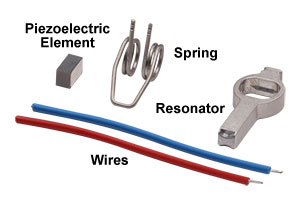
Click to Enlarge
The Components of the Elliptec Motor
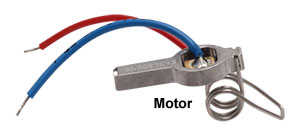
Click to Enlarge
The Elliptec Piezoelectric Resonant Motor
The Elliptec® Piezoelectric Resonant Motor
Thorlabs' Elliptec® piezo resonant motor, shown at right, is lightweight, with a mass of 1.2 g, and compact: the dimensions of the resonator housing, excluding the spring, are 8 mm x 4 mm x 20 mm.
Components of the Motor
The components that compose the motor are shown at far-right. The piezoelectric element is press fit into the aluminum resonator, which has been precisely designed and machined to produce the desired elliptical motion at the tip and to interface optimally with the driven module. The free ends of the spring are integrated with the resonator housing. The wires, which are soldered to the top and bottom of the piezoelectric element, deliver the voltage signal that induces the piezoelectric element to vibrate at ultrasonic frequencies.
When the motor is built into a system, the open loop of the spring is bolted to a sturdy surface that is stationary with respect to the item to be driven, and the tip of the resonator is placed in contact with the item. The purpose of the spring is to maintain constant contact between the tip of the resonator and the driven item, and the direction of motion is determined by the resonance frequency at which the piezo element is driven.
Elliptical Motion and Comparison with Conventional Motors
The motor is operated by driving it at one of its two resonance frequencies. A voltage signal oscillating at an ultrasonic frequency is applied to the piezoelectric chip, which responds by expanding less than a micron and then contracting back to its original dimensions at the frequency of the driving signal. This rapid-cycling change in the chip's dimensions causes a vibration in the aluminum resonator housing. When the vibration is at one of the housing's resonance frequencies, a pushing motion results at the tip of the motor. When the vibration is at the other resonance frequency a pulling motion results.
As illustrated in the video, the pulling and pushing motions result from the tip of the motor tracing an elliptical path in space when the motor operates at resonance. The selected resonance frequency controls the direction of the cyclical motion. The motor's tip traces one half of the ellipse as it expands and the other half as it contracts. When the motor pushes the driven item, the motor's tip is in contact with the item while the tip expands; the two are not in contact while the tip contracts. The converse is true when the motor pulls the driven item in the opposite direction. The total displacement at the tip of the motor is a function of both the mechanical load it is driving and the voltage supplied to the piezo element. The maximum displacement can be up to a few microns when the peak driving voltage is 5 V.
The motor behaves in many ways like a DC or electromagnetic stepper motor, but it does not suffer from many of the drawbacks of these conventional motors. Unlike conventional electromagnetic motors, which must overcome inertial delays to come to a stop, the highly dynamic Elliptec motor can stop within microseconds. As it has no gears, it does not exhibit backlash. Since it possesses no magnets, it is compatible with use in environments sensitive to electromagnetic interference. The motion of the driven element is continuous and smooth. As the tip of the motor must be in contact with the driven item to induce motion, the motor possesses the safety feature of an inherent friction brake. When in contact with a plastic surface, the motor operates virtually silently.
For OEM applications, the motor can be manufactured in volume at low cost, and it can be driven by inexpensive analog electronics. It does not require microprocessors or software; however it is compatible for use with them.
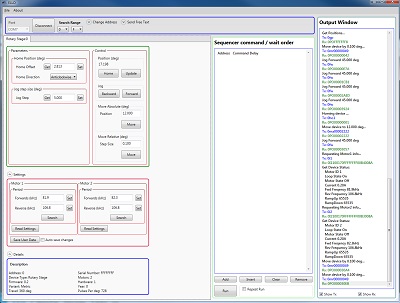
Click to Enlarge
The Elliptec Piezoelectric Resonant Motor Control Software GUI
Software for Devices Driven by Elliptec® Piezoelectric Resonant Motors
All devices based on the Elliptec® resonant piezo motor may be controlled by the Elliptec system software, which features an intuitive graphical user interface (GUI). The source code, in C# format, is included in software bundle available for download, and custom applications can be created in any language. The image at right shows a screen capture of the GUI, and the button that follows links to the download page.
Commands are entered in the Sequencer command / wait order section located at the center-left of the GUI. An example of a sequence of commands that might be sent to the device is "Aho0" to move to the rotation stage at address "A" to the home position in the clockwise direction, and then "Afw" to move the stage at address "A" forward by the jog increment. The command "As1" is used to perform the frequency search that will identify the optimal resonant frequencies, for the current operating conditions, for Motor 1 at adddress "A."
| Posted Comments: | |
kai zhang
(posted 2024-09-19 17:28:02.753) Dear After-Sales Technical Support,
We have encountered an issue with the ELL14-rotary mounting bracket that was purchased from your esteemed company. The device is capable of connecting but fails to rotate. We would greatly appreciate it if you could contact us at your earliest convenience to collaboratively address this matter.
Furthermore, while awaiting your technical support, are there any straightforward troubleshooting steps that we could attempt? We look forward to receiving a response from your technical department and are immensely grateful for your assistance.
Best regards. spolineni
(posted 2024-09-30 04:57:40.0) Thanks for contacting us. I will reach out to you personally to assist with troubleshooting and resolve the issue. user
(posted 2024-07-24 14:25:09.487) I would like to control the ELL14 device via LabView, could you also send me the LabView examples please? do'neill
(posted 2024-07-30 07:27:25.0) Thank you for your comment. I will reach out to directly to provide you an example. Karthickraj Muthuramalingam
(posted 2024-07-16 15:19:01.783) Is ELL14-like product available for 2inch optics rotation? cstroud
(posted 2024-07-22 11:07:26.0) Thanks for reaching out. We do not currently have a 2 inch version of the ELL14, we will pass this product suggestion along to our engineers. user
(posted 2024-07-08 14:06:33.21) Could you send me example vis for operating ELL14 via LabView? Thank you cstroud
(posted 2024-07-09 10:34:11.0) Thanks for reaching out. I will contact you directly to send over the Elliptec Labview examples. user
(posted 2024-06-06 11:57:30.92) I appreciate it if you could send me example vis for operating ELL14 via LabView. cstroud
(posted 2024-06-13 08:10:22.0) Thanks for reaching out. I will contact you directly to send over the Elliptec Labview examples. user
(posted 2024-05-30 10:08:04.56) I've seen below a reqeust for a 50 mm version of ELL14. Do you have concrete plans to release an ELL14 for 50 mm optics? If so, on what time line? Thanks do'neill
(posted 2024-06-03 05:50:30.0) Thank you for you feedback, a 50mm version of the ELL14 is under development currently. I am not able to give a concrete leadtime on this but this should be released later this year. I will reach out to you to discuss this further. user
(posted 2024-05-13 16:20:33.48) Hi,
I saw that the description mentioned that the ELL14 should be operated with duty cycles of 40% or less. In the communication protocol spec, it mentioned that for continuous operation, velocity should be set 50-70% of the maximum.
If we're running a long-term experiment with lots of rotations (but not continuously), would it be recommended we follow the duty cycle recommendation, the velocity recommendation, or both (limiting duty cycle and velocity)?
Thanks! spolineni
(posted 2024-05-23 05:12:32.0) Thank you for reaching out. To ensure the best performance, we recommend following a 40% duty cycle and setting the velocity between 50-70% of the maximum to prevent overheating. I will personally reach out to provide further assistance. user
(posted 2024-03-16 18:08:35.72) Is it possible to control the motor via Labview? Could you share a basic version of the software? Thanks cstroud
(posted 2024-03-18 12:20:26.0) Thanks for reaching out. The Elliptec stages are controllable via Labview when using the DLL's, which are downloaded when installing the ELLO software. I will contact you directly to send over some examples. Lin Lin
(posted 2024-03-06 11:07:58.547) After one rotation round, I found that the mount could not return to its original (absolute) angle when I clicked home or stepped back to its original position.
Is there any problem with the hysteretic effect? Or how can I solve the problem? Looking forward to the solution. do'neill
(posted 2024-03-12 08:52:17.0) Thanks for reaching out with this. The accuracy of these stages should be 6.98 mrad (0.4°) and the homing repeatability should be 1.75 mrad (0.1°). I will reach out to you directly to see if it is beyond these limits and help troubleshoot this issue user
(posted 2024-02-16 10:55:05.083) any chance of a half size/12,5mm version ? spolineni
(posted 2024-02-26 06:49:29.0) Thank you for getting in touch with us. We are looking into your inquiry. In the meantime, we will contact you to discuss the details of your specific application. user
(posted 2023-12-23 16:46:40.74) Hello, my rotation mount will rotate by itself when I place it within coils under sweeping magnetic fields. Do you know what could be the cause of this? Thank you. cstroud
(posted 2024-01-03 06:33:34.0) Thank you for your enquiry. The Elliptec stages are generally unable to be used in a magnetic environment as this can affect the positioning and homing sensor. I will reach out to you directly to discuss this issue. Kévin MORVAN
(posted 2023-11-09 07:53:33.32) Hello, Could you send me an example of a Labview vi that drive the ELL14K. It will be very helpful. Tank you. do'neill
(posted 2023-11-13 07:20:41.0) Feedback from Daniel at Thorlabs. I will reach out to you directly to provide this example. Jeremy Chew
(posted 2023-09-29 01:50:59.663) Hi there,
I am looking to use the ELL14 to jog continuously. After using 0sv46, I can't seem to find a way to stop its rotation. Would appreciate if I can get help on this.
Thank you! do'neill
(posted 2023-10-10 06:38:00.0) Response from Daniel at Thorlabs. The serial command 0st (where 0 is your address) will stop the motor when in continuous motion. Details on this can be found on page 37 of the Communication Protocol. user
(posted 2023-09-14 19:32:47.073) Hello. Can I get sample C++ programs for ELL14 and ELLB? Thanks. do'neill
(posted 2023-09-22 06:50:05.0) Response from Daniel at Thorlabs. I will reach out to you directly with this. Rishav Koirala
(posted 2023-09-14 11:47:32.717) Hello, could you please share some LabVIEW examples to interface with this mount and program it? That would be very helpful. Thanks. do'neill
(posted 2023-09-15 07:17:32.0) Response from Daniel at Thorlabs. I will reach out to you directly to discuss this and provide some examples. user
(posted 2023-07-12 12:37:34.31) Hi, I am unable to connect to the ELL14 via the Elliptec software--it is unable to detect the device. When I plugged it in for the first time, the drivers did not get installed either. How can I resolve this? do'neill
(posted 2023-07-20 06:15:28.0) Response from Daniel at Thorlabs. I am sorry to hear this. I will reach out to you directly to help troubleshoot this with you. user
(posted 2023-07-12 19:28:14.883) Hi, is it possible to control the rotation speed of the device? I read that the maximum speed is 430 degrees/s, I'd like to tune the speed with custom values up to the maximum one.
Thank you very much for your kind attention and help do'neill
(posted 2023-07-20 05:28:55.0) Response from Daniel at Thorlabs. Whilst these are not designed to be velocity controlled the SV command in the communication protocol can be used to slow the speed but can not be used to set an exact velocity. I will reach out to you directly to discuss your application user
(posted 2023-06-28 15:32:35.677) Hi,
I'm using several rotation mounts ELL14K, and I'm having issues with the last I ordered recently. When setting a position, it takes longer that it should (compared with the others I have, which work fine), making a different sound; it seems it reaches the position and then the the piezos keep vibrating or moving for a second or so. And sometimes I get the error "Device error: Mechanical Timeout". I already reboot the system and reset to factory settings, and cleaned the black bearing with alcohol, though I always manipulated it with gloves. The device has a couple of days of use, and I detected this since the beginning. Do you have any insight of what it could be and how to fix it?
Many thanks in advance do'neill
(posted 2023-06-29 11:51:54.0) Response from Daniel at Thorlabs. There are a few things this could be, I will reach out to directly to try and help you troubleshoot this with you. user
(posted 2023-06-14 08:15:17.473) Hi, I moved the ELL14K to a new PC with Windows11 but it is not recognized anymore via USB. None of the USB ports seems to work, and no driver is installed, then the software does not detect the device, while other devices are correctly working. Thank you very much in advance for your kind support. user
(posted 2023-06-06 14:35:38.597) Hi, trying to program an ELL14 -- would it be possible to get some sample Python code in controlling this device? Thank you. do'neill
(posted 2023-06-07 05:57:05.0) Feedback from Daniel at Thorlabs. I will reach out to you directly to provide this example. user
(posted 2023-05-15 12:35:45.11) Hi, would it be possible to get some labview VI examples for this mount? Thanks! do'neill
(posted 2023-05-16 12:25:56.0) Response from Daniel at Thorlabs. Thank you for your enquiry. I have reached out to you directly to provide an example VI. Thanmay Menon
(posted 2023-04-10 17:14:47.78) Hi, I was wondering if Thorlabs would be willing to provide some labview VI examples to help control the mount? JReeder
(posted 2023-04-12 03:18:50.0) Thank you for your enquiry. I have reached out to you directly to provide an example LabVIEW VI for this product. Alastair Curnock
(posted 2023-02-28 15:48:31.333) I have been using several of the ELL products for the last couple of years with great success for my requirements.
Do you have any plans to release more products in this range?
I would be extremely interested in a version of the ELL14 designed for an SM2 mount, for use with 50mm/2" diameter components JReeder
(posted 2023-03-01 08:29:42.0) Thanks for your enquiry. We are constantly developing more products for our customers and we currently do plan on releasing more Elliptec devices. I have logged your request in our internal engineering forum. user
(posted 2023-02-20 12:40:07.54) Hello, would it be possible for you to send me Labview sample code to control this please? Thank you in advance. do'neill
(posted 2023-02-20 09:44:36.0) Response from Daniel at Thorlabs: Thank you for your enquiry, we will reach out to you directly to help support this. Joelle Youssef
(posted 2023-02-07 13:32:15.473) Hello, the software for Devices Driven by Elliptec® Piezoelectric Resonant Motors is not downloading.
Thank you do'neill
(posted 2023-02-17 06:48:25.0) Response from Daniel at Thorlabs: I am sorry to hear you are finding this, I will reach out to you directly to help troubleshoot this. user
(posted 2023-01-19 16:46:46.833) Hi! Do you have any MATLAB examples to control this device? if not, could I get some help in setting up to communicate with ELL14 in MATLAB environment?? DJayasuriya
(posted 2023-01-20 09:12:05.0) Thank you for your inquiry. We have got in touch with you directly. user
(posted 2023-01-18 12:04:58.387) Hello, Could you send some Labview examples if you have any? thank you in advance. do'neill
(posted 2023-01-19 09:12:36.0) Response from Daniel at Thorlabs: Thank you for your inquiry. We will get in touch with you directly to support this. Jooyeong Yun
(posted 2023-01-12 02:27:16.93) Hi, Can I get customized ELL14k to support faster rotation above 1800 degree/s and possibly with 2inch aperture? if not, are there other products that can support these specs? (The faster the better) I could not find any and would appreciate your help. Thanks! fguzman
(posted 2023-01-12 09:34:42.0) Thank you for your enquiry. The maximum speed for the ELL14 is 430 deg/sec, and has a 1" aperture. We will contact you directly to discuss your application. fguzman
(posted 2023-01-12 09:34:42.0) Thank you for your enquiry. The maximum speed for the ELL14 is 430 deg/sec, and has a 1" aperture. We will contact you directly to discuss your application. Ariel Chua
(posted 2022-12-14 12:18:21.557) I have 2 ELL14 rotation mounts connected to the interface board, through device 1 port and device 2 port. I am trying to get both device 1 and 2 to rotate through an angle of 180 degrees (at intervals of 1 degree, from 0,1,2….179,180) simultaneously, by using python. However, i've only managed to get one to rotate after the other one has completed rotation.
In addition, is there a lab view code available for the controlling the 2 ELL14 rotation mounts? (simultaneous rotation of both). It would be great if there are also guides for the hardware required for this.
Thank you for your help cwright
(posted 2022-12-19 07:04:02.0) Response from Charles at Thorlabs: Thank you for your query. I would expect your code is waiting for the response from the stage before beinging the next move. The easiest way to move two devices at the same time would be to group the addresses so that a command to one stage is reacted to by both. I will reach out to you about this. user
(posted 2022-12-07 13:45:10.94) Hi. We are using an ELL14K. On an older PC (Intel Core i3-2120 (Fujitsu Esprimo), Windows 10 with newest updates) the ELL14K is not recognized via USB. None of the USB ports works, and no driver is installed. Consequently, the software does not detect the device. It is not a problem of the USB ports. Other devices are working fine.
However, on a new PC, a USB driver is automatically installed upon connecting the ELL14K, and the software works afterwards. Do we need a dedicated USB driver? cwright
(posted 2022-12-09 09:30:38.0) Response from Charles at Thorlabs: Thank you for your query. The interface board uses an FTDI chip to communicate with the ELL14 and I suspect this is not installed on your system. I will reach out to you to help resolve this. Daniel Heinrich
(posted 2022-11-22 16:47:21.723) I am using several ELL18 and ELL14 on an ELLB bus distributor. Every rotation stage keeps forgetting their assigned address and changes it to 0 after a power cycle (off/on) if I assign an address >9 (i.e., A-F). This means I have to manually detach all but one in order to reassign its address. Devices with addresses between 0 and 9 remember their addresses without a problem.
Is this a known issue and can I avoid this? DJayasuriya
(posted 2022-11-28 04:43:08.0) Thank you for your inquiry. If the address assigned is saved to user data, this shouldn't have to be assigned manually after a power cycle. We have got in touch with you directly to troubleshoot. Nirmala Kunwar
(posted 2022-10-24 16:29:36.337) We designing our own custom board to connect 3 of these stages. The board converts RS422 to RS232 TTL required for stages. The Tx output from stages is mentioned as open drain. Do we need to put an invert logic of Tx_out to match H/L voltages levels of RS232 or the stage's MCU will perform that logic internally?. Eg Pulling the pin down when L is required on Tx line and leave it floating when H is needed. We have added external pullup on the Tx out. user
(posted 2022-10-25 17:05:32.61) Hello. First, I would like to rotate the ELL14 continuously in one direction. However, I get an error "Device error: Command error", whenever I set the jog step to 0.0 value in order to rotate the mount continuously. Could you comment why? Second, I want to rotate the optics very slowly. Is there a way to control the velocity of the mount? Thanks in advance. cwright
(posted 2022-10-25 06:13:04.0) Response from Charles at Thorlabs: Thank you for your query. In order to get the continuous movement the manual calls for reducing the velocity. Setting it to between 50% and 70% before setting the jog size to 0.0 and initiating a jog is the correct procedure. You can reduce the velocity using the sv command. 0sv32 would reduce the velocity to 50% and 0sv46 would reduce it to 70%. These velocities are approximate only as these stages were not designed for precise velocity control. My example assume your stage's address is "0" but you can set the address to anywhere between 0-9 and A-F. user
(posted 2022-10-12 14:23:48.17) I plan to use ELL14 on a robotic arm, mounting some optics.
Therefore, it may operate in vibrating conditions.
Do you have any test results related to vibrating environments? cwright
(posted 2022-10-13 04:12:39.0) Response from Charles at Thorlabs: Thank you for your query. A member of technical support will reach out to you to discuss your application and how we could help. Chao Liu
(posted 2022-09-07 15:18:45.45) I want to control ELL14K using LabView, could you provide me the Vis? DJayasuriya
(posted 2022-09-07 10:46:36.0) Thank you for your inquiry. We will get in touch with you directly. user
(posted 2022-07-06 13:20:15.79) Hello, could it be possible to have a LabView code for this device ?
Thank you :) DJayasuriya
(posted 2022-07-07 04:44:54.0) Thank you for your inquiry. We will get in touch with you directly. jerome LEGRAND
(posted 2022-06-28 13:39:59.503) Hi
I will integrate a ELL14K device using LabView.
Have you got any exemples to explain how to communicate with this type of motion?
thanks Hehai Jiang
(posted 2022-06-24 15:11:22.663) Hi,
I want to customize one rotation mount with 2in aperture. Could you give me an estimated price and lead time? Thanks. cwright
(posted 2022-06-28 10:48:13.0) Response from Charles at Thorlabs: Thank you for your query. Unfortunately we cannot currently provide a 2" version of the ELL14. We do consider all customer requests and, as a frequently requested device, it is something we may look into as a future release. Patrick Tapping
(posted 2022-06-08 00:00:18.323) Hi,
I see that a few people are asking about controlling these Elliptec devices using python. I thought I'd let you and others here know I have written an free open-source python library which should be compatible with all the Elliptec devices.
Documentation: https://thorlabs-elliptec.readthedocs.io
Code: https://gitlab.com/ptapping/thorlabs-elliptec
PyPI Package: https://pypi.org/project/thorlabs-elliptec/
Hopefully it can help a few people out!
Patrick DJayasuriya
(posted 2022-06-09 04:07:02.0) Thank you for your feedback. This would be very helpful for lot our customers . DJayasuriya
(posted 2022-06-09 04:07:02.0) Thank you for your feedback. This would be very helpful for lot our customers . Aaron Riede
(posted 2022-05-11 09:15:34.133) Hi Thorlabs,
I bought an ELL14K and a ELL20K and asked for Python code examples earlier. It seems, I didn't get it. Could you please send me some python code to control the devices again? Thanks and best regards, Aaron cwright
(posted 2022-05-11 09:27:58.0) Response from Charles at Thorlabs: Hello Aaron. Thank you for reaching out again. We have sent you examples and advice on programming in response to both your previous feedbacks. Perhaps our emails are in your spam folder? We have also tried calling but could not reach you. Please email us at techsupport.uk@thorlabs.com so we can get back to you. user
(posted 2022-05-05 15:59:23.687) Please engineer the interface board more securely. I have had several boards with lifted pads due to excessive force on the 5V barrel connector. The damage is impossible to repair. The only mechanical support at the moment is two small solder joints, and a small tab of metal.
Morever, the interface board is not sold separately (only as part of the $560 bundle), making the problem worse.
This comment applies to all Elliptec devices. DJayasuriya
(posted 2022-05-09 03:52:37.0) Thank you for your feedback. Our engineers are looking into this and we have got in touch with you directly to resolve the issue. user
(posted 2022-05-02 14:16:27.733) Hi Thorlabs, I bought an ELL14K and a ELL20K. Can you please provide a python code to control the devices? Thanks and best regards, Aaron DJayasuriya
(posted 2022-05-03 09:16:18.0) Thank you for your inquiry. We will get in touch with you directly on how you can use Python to control the device. user
(posted 2022-04-18 10:42:48.98) I have two ELL14K and will buy two ELL14 and one ELLB to control the four ELL14 simultaneously.
Do I need more things to control four ELL14?
And would you please send me a Labview example?
By the way, would you please share some tips to fix the pcb circuits on the optical table safely?
I sometimes have to do it, but I did not find a fancy way. cwright
(posted 2022-04-19 05:20:00.0) Response from Charles at Thorlabs: Thank you for your query. To control 4 ELL14 over USB you would need 1 ELLB, 1 USB interface board (provided with the ELL14K kit) and a power supply with sufficient current for 4 devices. An example 4A PSU from a third party, such as the MeanWell GST25B05-P1J, could be used. I will reach out by email to send an example VI.
Unfortunately we do not currently have a dedicated method of securing the PCB to an optical table but you could use our cable management straps (CS1) to hold it down. Aaron Riede
(posted 2022-04-07 08:42:19.627) Hi Thorlabs, I bought an ELL14K and a ELL20K. Can you please provide a python code to control the devices?
Thanks and best regards, Aaron cwright
(posted 2022-04-07 05:37:13.0) Response from Charles at Thorlabs: Thank you for contacting us. We do have a couple of relevant examples and I will reach out to you with these. Ori Golani
(posted 2022-03-08 19:32:05.29) Hi Thorlabs,
I have two ELL14, each connected with its own interface board to a different USB port.
Two questions:
1) When using the GUI, I can only connect to one device a a time. The "add new device" button only searches for devices on the same USB port, and doesn't allow to change the port. How can this be solved?
2) Can you please provide a python code to control the devices?
Side note - this seems to be a repeating issue in the feedback threads. Maybe add an example code directly in the site? cwright
(posted 2022-03-09 05:54:39.0) Response from Charles at Thorlabs: Thank you for contacting us. The ELLO software can only connect to one COM port for each instance of the software. You can run two instances of the software together or use two devices on a single ribbon cable. There are instructions for doing so in the manual. Python examples are limited but technical support will reach out to you regarding this. Local technical support can also be reached directly using the details at this link: https://www.thorlabs.com/locations.cfm user
(posted 2022-02-28 14:12:32.72) Hi. Can you provide sample Labview code for communicating and rotating with ELL14K? cwright
(posted 2022-02-28 10:52:31.0) Response from Charles at Thorlabs: Thank you for contacting us. I will reach out to you regarding the use of these devices in LabVIEW. Haiyun Guo
(posted 2022-02-17 17:42:14.177) Hi, my product is actually in some trouble now. It seems not to move /rotate anymore. It always shows "Device error: Mechanical Timeout". I really don't know how to fix it and need help! I tried to restore factory settings several times, but it didn't work too. I even cannot click "Home". Please help me and email me back! I appreciate! cwright
(posted 2022-02-18 10:59:51.0) Response from Charles at Thorlabs: Movement issues are almost always due to the presence of dirt/finger oils etc on the black rail, contacted by the motors. We would recommend to take a link free tissue and thoroughly clean the black bearing with isopropyl alcohol. Please avoid touching this part with bare hands. user
(posted 2022-02-02 05:08:24.993) Can you please provide examples of Labview and Python code for communication with ELL14K?
We would like to integrate the ELL14K into a measurement system that is also to be used remotely. Therefore, it could be that the USB connection already exists before booting (in contradiction to the note "INF092T Issu B"). What exactly is the possible problem or consequences? Could an additional USB hub or USB isolator (for galvanic isolation) help? DJayasuriya
(posted 2022-02-03 04:05:26.0) Thank you for your inquiry, of course we will get in touch with you directly. The manual advises booting up the PC before the USB connected. However, if you have a interface board version 2 or later this shouldn't be an issue. fred cha
(posted 2022-01-09 04:50:06.877) Hi bis,
I found the problem due to the fact that the ELL14 interprets hex format only in upper text and not in lower text !
Sorry for disturbance
Fred cwright
(posted 2022-01-10 06:37:47.0) Response from Charles at Thorlabs: Thank you for your query. I am glad you quickly came upon the solution. For posterity, yes, although the commands issued by the host are in lowercase (6ma for example), the following position information (6ma00004DC7) for example, must be in uppercase Hex. fred cha
(posted 2022-01-09 04:37:11.97) Hi,
I am using python to drive an ELL14 and z simple spin button to send the angle target to the drive. In a strange fashion, some values are correctly interpreted and some not. Hereafter is a file with the sent command and the received answer :
1ma00001130 b'1PO00001133\r\n'
1ma000012c0 b'1PO00000001\r\n'
1ma00001450 b'1PO00001451\r\n'
1ma000015e0 b'1POFFFFFFFE\r\n'
1ma00001770 b'1PO0000176E\r\n'
1ma00001900 b'1PO000018FD\r\n'
1ma00001a90 b'1PO00000001\r\n'
1ma00001c20 b'1PO00000000\r\n'
1ma00001db0 b'1PO00000000\r\n'
1ma00001f40 b'1PO00000000\r\n'
1ma000020d0 b'1PO00000000\r\n'
1ma00002260 b'1PO00002263\r\n'
With some values, even while repeating the order, the position is not correctly interpreted.
Thanks for your answer.
Fred user
(posted 2021-11-26 12:17:58.703) Hi Thorlabs, I recently purchased two ELL14 that I am controlling with a distribution and interface board. I was hoping to be able to tap into the J1 connector and use the rising edge of the "In motion" signal as a hardware trigger for the next stage of my experiment. I've soldered a couple of wires to the pins (4 and 1) of the J1 connector in the distribution board and have been looking at the "In Motion" voltage on a high speed oscilloscope. Unfortunately (for my purposes) the "In Motion" voltage doesn't appear as a single transition between TTL high -> TTL low -> TTL, but as several TTL transitions (i.e. the "In Motion" voltage will flip from high to low 4 or sometimes 6 times per movement). Just wondering if this was expected or if there was a setting I could adjust to correct this, or if there is another way to get a TTL OUT that indicates the stage has finished? Thanks. cwright
(posted 2021-12-06 09:26:33.0) Response from Charles at Thorlabs: Thank you for your query. The In Motion pin will change state any ime there is motion, whether during a jog, home or frequency search. This means you may see multiple transitions, especially if a frequency search is performed. This pin will also change state if a move fails to compelte, as it may still have moved. It is advisable to trigger other equipment on the result of the status message which is sent when a move either finishes, successfully or not, or when a timeout occurs. I will reach out to you to help with this. Gabriel Puebla
(posted 2021-11-23 02:54:57.437) Is there a 12.7 mm version? Or a two PCB version? My max form factor for the mechanics would be 40 mm by 40 mm. cwright
(posted 2021-11-23 06:57:39.0) Response from Charles at Thorlabs: Thank you for your query. Presently there is no 12.7 mm version and this is the only format available. Tim Dinneen
(posted 2021-10-29 13:41:12.64) Can you provide sample Labview and Python code for communicating with ELL14K? cwright
(posted 2021-11-02 09:41:58.0) Response from Charles at Thorlabs: Thank you for your query. I have reached out to you to discuss your needs and see what we can provide you with. Jonathan Mortlock
(posted 2021-09-14 06:15:36.75) Hi, We are looking into this product for use in an experiment controlled by TTL signals. Is it possible to control motion via TTL signals to J1 Lines 6,7 after the mount has been set up/programmed over USB from the GUI using the supplied interface board? Could we access these lines by simply soldering on a connection to the supplied interface board, e.g. across the existing switches?
Thank you YLohia
(posted 2021-12-23 10:33:42.0) Hello, thank you for contacting Thorlabs. Yes, this should work. The buttons pull the pins to ground as they are "active low". We have confirmed that it works by using the trigger output from an MFF101 to initiate homing of the Elliptec device when the MFF swapped position. user
(posted 2021-09-07 11:06:13.157) Hello,
I am using two ELL14 rotation mounts (one fixed vertically and the other horizontaly). It happens often that they suddenly rotate the optics to a random position. I am not sure if this is due to power fluctuations or to system vibration (or something else). Is this a common issue? Do you have any suggestion to solve this problem? Thank you and best regards. cwright
(posted 2021-09-08 08:45:01.0) Response from Charles at Thorlabs: Thank you for your query. If you are using connecting directly to the ribbon cable, rather than the interface board, then pins 5, 6 and 7 should be tied high. If you are using the interface board then this is not a common issue and we would need to know more information to diagnose this. We will reach out to you directly to help troubleshoot this. cwright
(posted 2021-09-08 08:45:01.0) Response from Charles at Thorlabs: Thank you for your query. If you are using connecting directly to the ribbon cable, rather than the interface board, then pins 5, 6 and 7 should be tied high. If you are using the interface board then this is not a common issue and we would need to know more information to diagnose this. We will reach out to you directly to help troubleshoot this. user
(posted 2021-05-05 10:59:32.66) Hi, I've recently purchased the ELL14 rotation mount. I noticed that the total rotation range is limited. I was wondering whether it is an electronic or mechanical limitation and if it could be possible to configure the device for continuous rotation over more than 2 or 3 full turns. Then, it would be great to receive, if possible, a few examples on how to control the device in MatLab environment. Thank you very much for your kind attention and support. jcater
(posted 2021-05-06 10:05:24.0) Response from Jack at Thorlabs. Thank you for your feedback. The travel range of the ELL14 is +/-720°, this is a limitation within the firmware. I will reach out to you to discuss alternative options. Whilst we do not have any Matlab examples, I will reach out to you to help with getting set up to communicate with your ELL14 in MATLAB. James Heath
(posted 2021-03-31 16:19:40.65) What is the maximum rotation acceleration? cwright
(posted 2021-04-06 06:36:41.0) Response from Charles at Thorlabs: Thank you for your query. The maximum acceleration achieved would be limited by the torque of the motors and the mass of the optic, as well as the orientation of the stage. The maximum specified torque is 0.01 N.m and you can use the equation torque = (moment of inertia)(angular acceleration), with the moment of inertia for a solid disc to determine the maximum acceleration of your load.
This would be greatest when the load is sitting on top of the vertical axis. If however the load is applied with the stage when the axis is horizontal, this is going to cause a bending moment on the bearings and thus extra friction. Josef Lazar
(posted 2021-03-31 14:12:23.043) Hello -
The ELL14 manual states that TTL digital lines INM, JOG, FWD and BWD are available... Are they available only in the J1 connector/picoflex cable, or are they also accessible elsewhere (like among the J2 or J3 pins groups)?
Thank you,
JL cwright
(posted 2021-04-06 09:46:09.0) Response from Charles at Thorlabs: Hello and thank you for your query. J2 is used during production for programming of the board and J3 is used for programming the magnetic encoder. There are no additional TTL lines available; only those in the J1 connector. Vincent Forster
(posted 2021-03-17 07:27:38.133) Hi, I am currently experiencing some troubles :
I have 4 ELL14 motors connected to a ELLB Bus Distributor that I control individually and it works well. However, the motors do sometimes forget their adresses that i have previously for some reasons. While one of them is able to keep his adress. I wonder how I can make sure that all of them keep their adresses and not only one of them.
Thank you in advance,
Vincent cwright
(posted 2021-03-18 07:41:28.0) Response from Charles at Thorlabs: Hello and thank you for your query. These devices all have a default address of 0 unless it has been changed at some point. When you connect them to the ELLB you must ensure they are communicating on different addresses and it sounds like you have done this. If these addresses, once allocated, are not saved to the device then they will be lost upon power cycling and the device will return to its previously set address. To persist the new address to a stage you must either use the "Save User Data" button under the Settings panel in our ELLO software, or send the "us" command to each stage. I.e. if you change address 0 to address 1, perhaps with the 0ca1 command, then you must also save this change by sending "1us" or clicking the aforementioned button. I will reach out to you to ensure this resolves your issues. Satya Undurti
(posted 2021-03-10 17:45:56.157) Hi,
I have all my instruments integrated to labview and I am also planning to integrate ELL14K into it. However, I don't find any LbView Vis. Could it be possible for you to send me an example and possibly a Vi library for operating this product. I would like to use a default value angular rotation, set angle, read angle and setting velocity as basic operations.
Thanks
Satya cwright
(posted 2021-03-12 08:43:56.0) Response from Charles at Thorlabs: Thank you for your query. There is not a VI library for these devices but I have reached out to you with a couple of examples. Raj Patel
(posted 2021-02-09 13:43:19.093) The communications protocol is unclear and difficult to understand other than by experts in RS232 devices and C#. It is unclear how to use the communications protocol in Matlab, LabView and Python. Some examples would be useful to adapt the C# code to other languages. cwright
(posted 2021-02-10 11:14:32.0) Response from Charles at Thorlabs: Hello and thank you for your feedback. Certainly this is an area where we could have more examples available and we will look at working on this in the future. Currently we do have some examples which we can provide and I will reach out to you to discuss your needs. KyungJun Lee
(posted 2021-01-26 17:35:44.113) Hello, I could not find the LabView example for the ELL14K and ELLB distributor on the website. I really need it for my research.
I want to controll several 'ELL14K's with ELLB distributor through Labview.
Could I please send me examples of it as well?
Thank you. cwright
(posted 2021-02-17 05:38:22.0) Response from Charles at Thorlabs: Thank you for contacting us. We reached out directly and have sent examples for communicating via LabVIEW. Hanjun Koh
(posted 2020-12-25 09:04:26.163) Hi, I am willing to control two rotation ELL14K individually and ELLB bus distributor by using Arduino. Could you send me Arduino examples?
Also I would like to receiving the data from PM101 power meter by using Arduino. Please let me have Arduino example program. cwright
(posted 2021-01-05 10:56:11.0) Response from Charles at Thorlabs: Hello and thank you for your query. You can also contact your local technical support directly using the contact details on our site: https://www.thorlabs.com/locations.cfm
Unfortunately I do not currently have an Arduino available and we do not have ready made examples for these cases but I would suggest looking at the official Arduino serial documentation and using the Serial.readBytesUntil()until the Termination character in the command protocol is reached: https://www.arduino.cc/reference/en/language/functions/communication/serial/
The ELL devices are 5V tolerant so you can use these directly with the Arduino. The command protocol contains the serial parameters and controls which you can use to communicate with the devices.
The Elliptec command protocol can be found at the following link:
https://www.thorlabs.com/Software/Elliptec/Communications_Protocol/ELLx%20modules%20protocol%20manual.pdf
There is a also a guide for using the PM101 with a microcontroller which can be found here: https://www.thorlabs.com/_sd.cfm?fileName=MTN013681-D04.pdf&partNumber=PM101
To use it with an Arduino you would need to switch it to UART mode to be 5V tolerant or use a bidirectional logic level shifter. The Serial Parameters, such as Baud Rate,Data Bits, Flow Control and Termination Character are detailed in this document. The commands you can send are also there.
I will reach out to you in case you have questions. Vincent Forster
(posted 2020-11-20 03:45:25.353) Hi I am willing to control two rotation mounts individually using the same ELLB Bus distributor, could you send me LabView or Python examples please ? cwright
(posted 2020-11-20 08:07:03.0) Response from Charles at Thorlabs: Hello and thank you for your query. We will reach out to you with a couple of examples for using two Elliptec devices. David Barbalas
(posted 2020-11-19 12:05:41.04) Is it possible to get the piezoelectric rotator and the IC control elements separately? We are looking for an in-situ rotation stage for a cryostat sample positioner and would like to be able to separate the piezoelectric drive in the cryostat from the electronics outside. cwright
(posted 2020-11-20 11:25:40.0) Response from Charles at Thorlabs: Hello David and thank you for query. Unfortunately we would not be able to supply the rotation mount separate from the drive electronics for low order quantities as modifications to the boards are something which would require significant R&D. I will reach out to you to discuss your application. user
(posted 2020-09-21 08:18:14.9) Hello, I could not find the LabView example for the ELLO14k on the website, which was helpful to many people. Could I please send me a copy of it as well? cwright
(posted 2020-09-23 03:21:00.0) Response from Charles at Thorlabs: Hello and thank you for contacting us. I have reached out to you by email with an example. Stefano Pirotta
(posted 2020-08-21 23:27:39.55) Dear all, I would like to come back to the question about arduino or raspberry connection.
If I want to connect ELL* motor to arduino: can I directly use the TX and RX pins of arduino to connect to pin 2 and 3 of the 8 way Picoflex male SMD ? Do I need an TTL to RS232 adapter? Arduino is 5V, while ELLx wants 3.3V max: do I need another adapter?
And for the raspberry? Again an adapter is necessary?
Thanks
stefano cwright
(posted 2020-08-26 10:00:00.0) Response from Charles at Thorlabs: Hello Stefano. You do not need an adapter of any kind to use it with the Arduino. These elliptec devices are designed with the 3.3V LV TTL levels in mind but are 5V TTL tolerant. You can connect it directly to the Arduino. For the Raspberry Pi, whose GPIO pins are 3.3V, you could use a logic level shifter but a voltage divider made from a couple of resistors would also work to enable the Rpi to receive messages from the Elliptec module without damage. If you need advice setting this up, or initiating communication with the device,your local technical support team will be able to help. user
(posted 2020-07-01 07:42:04.147) Dear Sir.,
I wrongly bought ELL4 product instead of ELL4k.
Can I now buy the interface board, power supply and cables to ? I cannot find them on you site,
thanks,
regards,
Genni cwright
(posted 2020-07-02 08:42:12.0) Response from Charles at Thorlabs: Hello Genni and thank you for contacting us. Typically when such component items cannot be found on the site, your local technical support team can provide you with a quote for them. I will reach out to you directly about this. Youngchul Kim
(posted 2020-05-31 23:52:33.91) Can I also have a labview example?
I love the item except that the cable needs to point outward, not toward the center (optics area). DJayasuriya
(posted 2020-07-15 07:51:04.0) Thank you for your inquiry. I will get in touch with you directly to send the examples. DJayasuriya
(posted 2020-07-15 07:51:04.0) Thank you for your inquiry. I will get in touch with you directly to send the examples. F-A Bégin
(posted 2020-05-27 14:19:01.76) Hi!
Can the deg/jog value can be set to another value and keep this value even though the ELL14 is shut down. Like setting the default value to 2 or 3 deg instead? Also, can you please sent me the LabVIEW sample VI? DJayasuriya
(posted 2020-06-03 10:01:47.0) Thank you for your inquiry. Yes you would be able to set a default value. You would have to save it using the "USER SAVE" button or send the command "us", i.e. 0us for a unit at address zero "0". We will get in touch with you directly for the LABVIEW VI. Dennis Wilken
(posted 2020-03-17 17:28:31.597) I want to program some ELL14 rotation stages. My start, however, was a bit bumpy.
The programming guide doesn't feel userfriendly. I would prefer some less cryptic headings. Why do you use headings like "_DEVGET_INFORMATION" is this some kind of standard that I don't know of? The commands seem to be in random order. To find the commands I need, I had to scroll through the whole document.
However, I decided to send you feedback because I couldn't figure out how to translate the rotation position in degrees into the encoder unit. For the translation stages, you give the conversion factor 2048/mm but there is no equivalent for angles. Just "262144 (40000H)" but I couldn't figure out what this means. From your software, I derived that it should be 398.22/° or 1 encoder unit corresponds to 0.0025°. Could you explain how I should do the conversion properly?
I really appreciate your product and hope to implement it soon.
Best,
Dennis Wilken cwright
(posted 2020-03-19 05:02:59.0) Response from Charles at Thorlabs: Hello Dennis and thank you for your feedback. I agree that the communications protocol can be a little unclear and we are currently looking into revamping and updating our Elliptec documentation. The control messages are indeed not listed in any particular order.
The 262144 (40000H) you refer to is actually an out of date specification as the encoder we used to use was obsoleted, forcing a redesign. The first value is the number of counts to the encoder and the second is this same value represented in Hex. If you query the position of the stage in device units, then encoder counts expressed in Hex is what you will receive.
If you refer to the specifications of the ELL14 on the device’s webpage you will see that it has the following values for the encoder (143360 counts/rev, 43.8 µrad/count, 0.0025°/count) so you have derived the correct value. For now I would suggest checking the values stated on the relevant webpages for these products and we will look at correcting the guide as soon as possible.
I will reach out to you directly to see if we can be of further assistance. Brent Sperling
(posted 2020-03-06 09:09:17.303) Do you have any plans on making a 2" version of this? It looks pretty awesome! cwright
(posted 2020-03-09 10:00:33.0) Response from Charles at Thorlabs: Hello Brent and thank you for your feedback. I am not aware of this currently being worked on but I will forward your comments to our engineers and see if this is something they will consider the next time they look at updating this range of products. Amit Finkler
(posted 2019-11-25 04:39:00.07) Can you please send me the LabVIEW sample VI? cwright
(posted 2019-11-27 05:06:53.0) Response from Charles at Thorlabs: Hello Amit. Yes of course, I will contact you with a short example. Fabio Barachati
(posted 2019-11-22 08:16:28.197) Hello,
We have two ELL14 rotation mounts. It happens almost daily that they suddenly "reset" themselves and rotate the optics to a random position. We noticed that this seems to be caused by power fluctuations, e.g. when someone turns an equipment or computer on nearby. This happens also when each interface board is connected to their own power supply, in addition to the USB port. Is this a common issue? Tips?
Thank you and best regards,
Fabio cwright
(posted 2019-11-27 05:07:05.0) Response from Charles at Thorlabs: Hello Fabio, thank you for contacting us about this issue. It is not one we are aware of and I will reach out to you directly to troubleshoot and diagnose this. Mikkel Bregnhøj
(posted 2019-10-30 04:39:58.277) Hi Thorlabs. I would like to report a bug in the Ello software when using two ELL14 rotation mounts through the ELLB serial bus.
The units work just fine (and independently) when controlled through the manual control panel. However, when trying to perform an automated seqeunce of moves through the "sequence control panel", the units fail to respond individually. Instead they move together as one unit. This does not appear to be a problem if they are controlled by external software.
I hope this helps you improve the software. cwright
(posted 2019-10-30 09:54:07.0) Response from Charles at Thorlabs: Hello Mikkel, thank you for contacting us about your issue. Unfortunately I cannot replicate your problem so I will contact you directly to diagnose this. Philipp Hanke
(posted 2019-10-28 14:00:02.663) Hello, is it possible to control the ELL14K rotary stage via LabVIEW too? Could you please provide the example VI library. Another question is: how to control two of the ELL14K stages separately via LabVIEW with on Interface board and one bus distributor.
Thank you and best regards, Philipp Hanke cwright
(posted 2019-10-29 09:09:37.0) Response from Charles at Thorlabs: Hello Philipp, thank you for your query. Yes this is possible using the Thorlabs.Elliptec.ELLO_DLL.dll library found in the Elliptec installation directory. I will contact you directly with an example. If using multiple devices from the same bus or interface board then they must be assigned separate addresses. Multiple devices can be controlled independently by sending commands to their separate addresses individually or in tandem by grouping their addresses before sending further commands. Manuel Martinez
(posted 2019-10-18 19:04:20.86) It is possible to control The ELL14 with arduino? cwright
(posted 2019-10-21 06:26:23.0) Hello Manuel,
Thank you for contacting us. This should be possible using serial commands from our communications protocol and a couple of RX, TX pins or SoftwareSerial to emulate them. The ELLO software we provide is essentially an example of a serial terminal emulator which an OEM might build for Elliptec devices to run on Windows and any device which can supply TTL or LV TTL signals at a baud rate of 9600 can be used with custom software to control these devices. user
(posted 2019-08-26 18:24:53.527) Can you comment on the vacuum compatibility?
(2 issues for vacuum compatibility - oils for lubrication and thermal heat dissipation)
Can you comment on potential Labview drivers being made available (eventuall)?
Thank you
Chris
Type of Vacuum (low or high vacuum)
Very few items are compatible with hard or high vacuum. Electron microscopes or other analytical instruments use a High/hard vacuum (10-9 Torr or nanoTorr)
However, for laser processing of materials, where you need to translate or rotate the sample, the vacuum we are interested in is considered a low/medium vacuum environment (10-6 Torr or microTorr)
This is the vacuum needed to avoid high energy laser breakdown at focus.
These new stages might well be vacuum compatible in a moderate (microTorr) vacuum environment.
Two issues make items incompatible with vacuum – oils and cooling.
(Oils)
1. Are lubricating oil or is a lubricating grease visible on the stage? There may be some lubrication on the rotation mount or linear translation stage mounts.
Ideally we would simply use a solvent (IPA, ethanol, methanol) to clean the grease. If necessary a small amount of silicon (vacuum compatible) grease would be added.
(Thermal)
2. Does the circuitry directly on the rotation stage rely upon air conduction for cooling?
If so - a small copper heat sink on the "hot" element takes heat and dumps it to the vacuum container.
For example, many more expensive stepper motors stages draw power to keep the stage locked (even when not moving) will thermally overload if put in vacuum unless separate cooling is provided.
These new stages appear to consume relative little power.
(Software)
3. Will there be Labview drivers available? AManickavasagam
(posted 2019-08-28 08:42:52.0) Thank you for your query. I will try to address your questions point by point. 1. Unfortunately only the motor itself is considered vacuum compatible and not the Elliptec devices. There is a small amount of lubricant in the bearing and I will contact you directly to provide further details. 2. The stage does use a very low current (50mA) when in standby but this increases to 800mA, at 5V, when in motion. Heavy or continuous use could cause the stage to overheat and vacuum conditions would of course exacerbate this. Furthermore these devices have only been tested at typical pressures and temperatures up to 40°C. 3. It is currently possible to control any of our Elliptec products using LabView via the .NET dlls which can be found in the ELLO installation folder. I will include an example VI when I contact you. Kyungdeuk Park
(posted 2019-08-02 00:34:33.987) Hi. I would like to know if thorlabs has any plan to provide LabView code for ELL14. Or could you provide us sample VI?
Thank you. AManickavasagam
(posted 2019-08-06 05:42:47.0) Response from Arunthathi at Thorlabs: Thanks for your query. I have contacted you directly with the sample VI. Fabio Barachati
(posted 2019-07-18 12:31:40.98) Hello,
I would like to know if it is possible to control the ELL14 rotary stage via LabVIEW and if Thorlabs could provide us with an example VI library.
Thank you and best regards,
Fabio Barachati AManickavasagam
(posted 2019-07-19 09:55:18.0) Response from Arunthathi at Thorlabs: Thanks for your query. Yes, this stage could be controlled with Labview (the dll files would be in the installation folder). Unfortunately, we do not have a VI library to send but we will contact you directly with a sample VI and documentation guide. cheng wang
(posted 2019-07-07 14:50:09.01) Is there any discount of ELL14K? We , Hefei university of Technology ,have bought many products of your company. AManickavasagam
(posted 2019-07-08 05:55:21.0) Response from Arunthathi at Thorlabs: Thanks for your query. We will contact you directly to discuss your options. Yi Wei Ho
(posted 2019-05-29 01:22:31.817) The Solidworks file is missing (only 24kb) while the .step file design is different than the actual product. Please kindly update the 3D model files as it is an interesting product to use in our setup. AManickavasagam
(posted 2019-05-30 06:07:43.0) Hello, thank you very much for your feedback! The files are corrected. |
Rotation Mount and Stage Selection Guide
Thorlabs offers a wide variety of manual and motorized rotation mounts and stages. Rotation mounts are designed with an inner bore to mount a Ø1/2", Ø1", or Ø2" optic, while rotation stages are designed with mounting taps to attach a variety of components or systems. Motorized options are powered by a DC Servo motor, 2 phase stepper motor, piezo inertia motor, or an Elliptec™ resonant piezo motor. Each offers 360° of continuous rotation.
Manual Rotation Mounts
| Rotation Mounts for Ø1/2" Optics | |||||||
|---|---|---|---|---|---|---|---|
| Item # | MRM05(/M) | RSP05(/M) | CRM05 | PRM05(/M)a | SRM05 | KS05RS | CT104 |
| Click Photo to Enlarge |
 |
 |
 |
 |
 |
 |
 |
| Features | Mini Series | Standard | External SM1 (1.035"-40) Threads |
Micrometer | 16 mm Cage-Compatible | ±4° Kinematic Tip/Tilt Adjustment Plus Rotation | Compatible with 30 mm Cage Translation Stages and 1/4" Translation Stagesb |
| Additional Details | |||||||
| Rotation Mounts for Ø1" Optics | ||||||||
|---|---|---|---|---|---|---|---|---|
| Item # | RSP1(/M) | LRM1 | RSP1D(/M) | DLM1(/M) | CLR1(/M) | RSP1X15(/M) | RSP1X225(/M) | PRM1(/M)a |
| Click Photo to Enlarge |
 |
 |
 |
 |
 |
 |
 |
 |
| Features | Standard | External SM1 (1.035"-40) Threads |
Adjustable Zero | Two Independently Rotating Carriages | Rotates Optic Within Fixed Lens Tube System |
Continuous 360° Rotation or 15° Increments |
Continuous 360° Rotation or 22.5° Increments |
Micrometer |
| Additional Details | ||||||||
| Rotation Mounts for Ø1" Optics | ||||||
|---|---|---|---|---|---|---|
| Item # | LM1-A & LM1-B(/M) |
CRM1T(/M) | CRM1LT(/M) | CRM1PT(/M) | KS1RS | K6XS |
| Click Photo to Enlarge |
  |
 |
 |
 |
 |
 |
| Features | Optic Carriage Rotates Within Mounting Ring | 30 mm Cage-Compatiblea | 30 mm Cage-Compatible for Thick Opticsa |
30 mm Cage-Compatible with Micrometera |
±4° Kinematic Tip/Tilt Adjustment Plus Rotation | Six-Axis Kinematic Mounta |
| Additional Details | ||||||
| Rotation Mounts for Ø2" Optics | |||||||
|---|---|---|---|---|---|---|---|
| Item # | RSP2(/M) | RSP2D(/M) | PRM2(/M) | LM2-A & LM2-B(/M) |
LCRM2A(/M) | KS2RS | K6X2 |
| Click Photo to Enlarge |  |
 |
 |
  |
 |
 |
 |
| Features | Standard | Adjustable Zero |
Micrometer | Optic Carriage Rotates Within Mounting Ring | 60 mm Cage-Compatible | ±4° Kinematic Tip/Tilt Adjustment Plus Rotation | Six-Axis Kinematic Mount |
| Additional Details | |||||||
| Rotation Drive Mechanism and Adjustment Range | Manual, 360° Continuous | Coarse: Manual, 360° Continuous; Fine: ±7° Micrometer |
Manual, 360° Continuous | ||||
| Optic Mounting | Internally SM2-Threaded Carriage | Internal SM2 Threads in LM2-A |
Internally SM2-Threaded Carriage | ||||
| Maximum Accepted Optic Thickness | 0.51" (13 mm) | 0.54" (13.7 mm) | 0.48" (12.2 mm) | 0.46" (11.7 mm) | 0.52" (13.2 mm) | 0.47" (12 mm) | 0.53" (13.4 mm) |
| Post Mounting | 8-32 (M4) Tap | 8-32 (M4) Tap in LM2-B | 8-32 (M4) Tap | Four Counterbores for 8-32 (M4) Cap Screws | Six Counterbores for 8-32 (M4) Cap Screws | ||
| Cage System Compatibility | N/A | Four 4-40 (M3) Taps on Rotation Dial with 60 mm Spacing |
N/A | Four Bores for Ø6 mm Cage Rods with 60 mm Spacing |
N/A | N/A | |
Manual Rotation Stages
| Manual Rotation Stages | ||||||
|---|---|---|---|---|---|---|
| Item # | RP005(/M) | PR005(/M) | MSRP01(/M) | RP01(/M) | RP03(/M) | QRP02(/M) |
| Click Photo to Enlarge |
 |
 |
 |
 |
 |
 |
| Features | Standard | Two Hard Stops | ||||
| Additional Details | ||||||
| Manual Rotation Stages | ||||||
|---|---|---|---|---|---|---|
| Item # | XRNR1(/M) | XRR1(/M) | PR01(/M) | CR1(/M) | XYR1(/M) | OCT-XYR1(/M) |
| Click Photo to Enlarge |
 |
 |
 |
 |
 |
 |
| Features | Fine Rotation Adjuster and 2" Wide Dovetail Quick Connect |
Fine Rotation Adjuster and 3" Wide Dovetail Quick Connect |
Fine Rotation Adjuster and SM1-Threaded Central Aperture |
Fine Pitch Worm Gear | Rotation and 1/2" Linear XY Translation | |
| Additional Details | ||||||
Motorized Rotation Mounts and Stages
| Motorized Rotation Mounts and Stages with Central Clear Apertures | |||||
|---|---|---|---|---|---|
| Item # | DDR25(/M) | PDR1C(/M) | PDR1(/M) | PDR1V(/M) | PDXR1(/M) |
| Click Photo to Enlarge |
 |
 |
 |
 |
 |
| Features | Compatible with SM05 Lens Tubes, 16 mm Cage System, & 30 mm Cage System |
Compatible with 16 mm Cage System |
Compatible with SM05 Lens Tubes & 30 mm Cage System |
Vacuum-Compatible; Also Compatible with SM05 Lens Tubes & 30 mm Cage System |
Compatible with SM05 Lens Tubes & 30 mm Cage System |
| Additional Details | |||||
| Motorized Rotation Mounts and Stages with Central Clear Apertures | |||||
|---|---|---|---|---|---|
| Item # | K10CR1(/M) | PRM1Z8(/M)a | DDR100(/M) | ELL14 | HDR50(/M) |
| Click Photo to Enlarge |
 |
 |
 |
 |
 |
| Features | Compatible with SM1 Lens Tubes & 30 mm Cage System | Compatible with SM1 Lens Tubes, 16 mm Cage System, 30 mm Cage System |
Compatible with SM1 Lens Tubes, Open Frame Design for OEM Applications |
Compatible with SM2 Lens Tubes |
|
| Additional Details | |||||
| Motorized Rotation Mounts and Stages with Tapped Platforms | ||
|---|---|---|
| Item # | PRMTZ8(/M)a | ELL18(/M)b |
| Click Photo to Enlarge |
 |
 |
| Features | Tapped Mounting Platform for Mounting Prisms or Other Optics | Tapped Mounting Platform, Open Frame Design for OEM Applications |
| Additional Details | ||

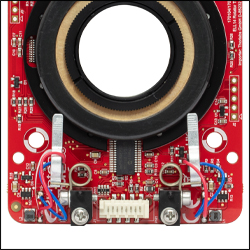
Click to Enlarge
The motors' aluminum tips contact the black plastic track encircling the rotation mount. This track should not be touched to prevent debris and oil building up on the track.
- Ideal for OEM Evaluation Testing
- Easily Integrate into a Setup
- Operate using Manual and/or Computer Control
- Included Power Supply is Required for Powering the Mount
The Rotation Mount Bundle is a complete package that includes the ELL14 rotation mount. The ELL14K package facilitates quick integration of the rotation mount into laboratory setups and other experimental applications. It also provides a convenient means to evaluate incorporating this technology into OEM applications.
The tips of both motor housings are in firm contact with the plastic track encircling the rotation mount, as can be seen in the image to the right. The motors are installed with opposite orientations and clockwise (and counterclockwise) rotation occurs when one motor pushes the track forward while the other pulls it backward.
| Included in the ELL14K Bundle | |
|---|---|
| ELL14 Rotation Mount | 5 V Power Supply with Region-Specific Power Adapter |
| Interface Board | 8-Conductor 28 AWG Ribbon Cable |
| USB Cable | PC-Based Software for Download |


Click to Enlarge
Features of the Rotation mount
This Rotation Mount is offered to meet the needs of applications whose designs require multiple networked Elliptec® resonant motor products. It possesses an SM1-threaded mount for holding Ø1" optics. Details describing the dimensions, including the spacing of mounting holes, and other specifications of the mount are given in the Specs tab. Please contact us to discuss customizing the rotation mount.
The PCB of the rotation mount incorporates a male 8-pin Picoflex® connector (header). Each ELL14 mount ships with the female 8-pin Picoflex® connector (receptacle) that mates with the connector (header) on the board.

| Specifications | ||
|---|---|---|
| Item # | ELLC2 | |
| DC Voltage Input to Controller | 4.5 to 5.5 V | |
| Typical Current Consumption Per Module | Movement | 800 mA |
| Standby | 50 mA | |
| Operating Temperature Range | 15 to 40 °C | |
| Ribbon Cable Length (1 Included) | 250 mm (9.84") | |
| Maximum Supported Ribbon Cable Length |
500 mm (19.68") | |
| Dimensions (Interface Only) | 66.0 mm x 32.0 mm x 12.5 mm (2.60" x 1.26" x 0.49") |
|
| Weight (Interface Only) | 10.8 g (0.022 lbs) | |
- Convert Any Single ELL Device into a Kit by Adding the Following:
- Handheld Controller
- USB Micro B Cable
- Picoflex®1 Cable
- 5 V Power Supply with Regional Adapter (US, UK, AU, or EU)
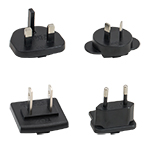
Click for Details
Region-Specific Adapters for the ELLC2 Power Adapter
Thorlabs' ELLC2 Accessory Upgrade Pack is designed to include all of the items necessary to convert any single ELL slider, stage, or mount into an ELL kit2. The included handheld controller features three buttons to control the position of a connected ELL stage and the USB port enables direct connection to a PC via the included USB Micro B cable. A 0.25 m Picoflex® cable with 8 loaded circuits that connects the handheld controller to the ELL device and a 5 V power supply with a regional adapter (US, UK, AU, or EU) are also included with the kit.
- Note: Picoflex® is a registered trandemark of Molex Incorporated.
- Mounting brackets for the ELL17(/M), ELL18(/M), and ELL20(/M) can be ordered by contacting Tech Support.

| Specifications | ||
|---|---|---|
| Item # | ELLB | |
| Voltage Rating | 4.5 to 5.5 V | |
| Typical Current Consumption Per Module | Movement | 800 mA |
| Standby | 50 mA | |
| Maximum Board Current | 4.0 A | |
| Operating Temperature Range | 15 to 40 °C | |
| Ribbon Cable Length (4 Included) | 250 mm | |
| Maximum Supported Ribbon Cable Length |
500 mm | |
| Dimensions | 65.0 mm x 32.0 mm x 12.5 mm (2.56" x 1.26" x 0.49") |
|
| Weight | 11 g (0.02 lbs) | |
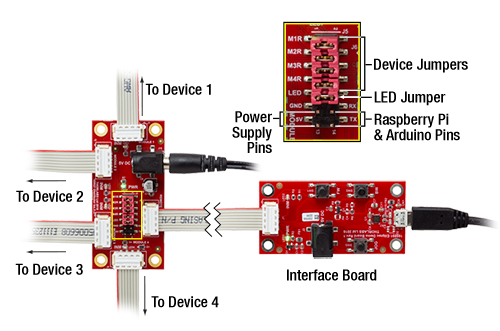
Click to Enlarge
A single bus distributor can be used to control up to four Elliptec devices. The bus can be connected to a PC using the interface board provided with the bundles sold above. Note that the bus is then controlled by the Elliptec software and that the buttons on the interface board are disabled.
- Control and Power up to Four Elliptec® Devices with One Bus
- Daisy Chain Bus Boards to Control up to 16 Elliptec Devices
- Controlled Remotely Using Elliptec System Software (See Software Tab Above)
- Connect to PC Using USB Interface Board Included with Elliptec Bundles
- Five Jumpers and Four 8-Conductor 28 AWG Ribbon Cables Included
- Compatible with Raspberry Pi® and Arduino® Boards
The ELLB Bus Distributor connects up to four Elliptec® devices. Connected devices can be controlled with or without the interface board included with the above bundles. When using the interface board, each connected device is controlled remotely by a PC running the Elliptec software package. The interface board connects to the bus's input port labeled REMOTE; once connected, the interface board's buttons are disabled. For control without using the interface board, see the Pin Diagrams tab for custom connections.
Multiple ELLB Bus Distributors can be daisy chained to control and power up to 16 Elliptec devices; simply connect one of the four MODULE outputs to the second board's REMOTE input. Indicator LEDs are provided to show which device is active. The communications protocol manual describes how to use the software to individually address each connected device. A link to download the software and accompanying documentation can be found in the Software tab.
The bus includes a Ø6.3 mm power connector that supports a 5 V supply with a maximum current of 4 A. As more devices are connected, simultaneous control of the units will require more current to be provided by the power supply; please see the Specs tab for the amount of current drawn by each Ellitpec device. A 5 V, 1 A power supply is included with the above ELL9 and ELL12 bundles. Depending on the current draw of the Elliptec devices connected, this supply provides enough current to power two devices simultaneously.
Fourteen control pins, detailed in the image to the right, are included for additional functionality. Four pairs of pins are each shorted with a jumper that, when in place, enables the Elliptec software to receive feedback from connected Elliptec devices. The pair of pins labeled LED is shorted with a jumper that, when removed, will disable the indicator LEDs. The 5V and GND allow an optional, user-provided 5 V, 2 A power supply to be used in place of a source connected to the Ø6.3 mm power connector. The RX and TX pins can be used to control the bus with a Raspberry Pi® or Arduino® board, respectively, instead of the Elliptec interface board.
The board is mounted using the Ø3.5 mm through holes provided in each corner. Four 8-conductor, 28 AWG ribbon cables are included.
| Compatible Elliptec Devices | |||||
|---|---|---|---|---|---|
 |
 |
 |
 |
 |
 |
| Multi-Position Sliders | 28 mm Linear Stage | 60 mm Linear Stage | Rotation Stage | Rotation Mount | Motorized Iris |
 Products Home
Products Home

















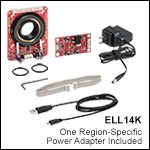
 Zoom
Zoom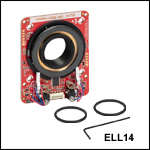
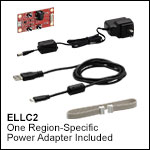
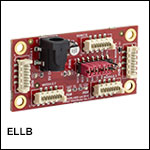
 Rotation Mount: Resonant Motor Driven
Rotation Mount: Resonant Motor Driven